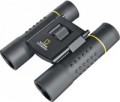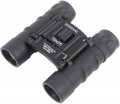Field of view 1 km away
The diameter of the area visible through binoculars / monoculars from a distance of 1 km — in other words, the largest distance between two points at which they can be seen simultaneously from this distance. It is also called "linear field of view". Along with the angular field of view (see below), this parameter characterizes the space covered by the optics; at the same time, it describes the capabilities of a particular model more clearly than data on viewing angles. Models with magnification adjustment (see above) usually indicate the maximum field of view — at the lowest magnification and
the widest angle of view. This information is often supplemented by data on the minimum value.
Real angle of view
The section of the panorama that can be viewed through the eyepieces of binoculars. The higher the actual angular field of view, the wider the visibility of the optics. Note that the angular field of view has an inverse relationship with magnification. That is, the higher the magnification, the narrower the visibility (the smaller the real angular field of view). The actual angular field of view is calculated as follows: you need to divide the angular field of view (in degrees °) by the magnification factor. In comparison, the human eye has an angular field of view of 60 arcseconds (“). In terms of degrees, you get 150 °. Good binoculars provide a real field of view somewhere within 10 arcseconds. But it does not always make sense to chase after large indicators of the real angular field of view. The fact is that when viewing a large section of the panorama, the edges of the image receive noticeable distortion.
Min. focus distance
The smallest distance to the observed object, at which it will be clearly visible through binoculars / monoculars. All such optical instruments were initially created for observing remote objects, therefore, not all of them are able to work at short distances. When choosing a model for this parameter, one should proceed from the expected observation conditions: ideally, the minimum focus distance should not be greater than the smallest possible distance to the observed object.
Twilight factor
A complex indicator that describes the quality of binoculars / monoculars at dusk — when the illumination is weaker than during the day, but not yet as dim as in the deep evening or at night. It is primarily about the ability to see small details through the device. The need to use this parameter is due to the fact that twilight is a special condition. In daylight, the visibility of small details through binoculars is determined primarily by the magnification of the optics, and in night light, by the diameter of the lens (see below); at dusk, both of these indicators affect the quality. This feature takes into account the twilight factor. Its specific value is calculated as the square root of the product of the multiplicity and the diameter of the lens. For example, for 8x40 binoculars, the twilight factor will be the root of 8x40=320, that is, approximately 17.8. In models with power adjustment (see above), the minimum twilight factor is usually indicated at the lowest magnification, but data is often given for the maximum. The lowest value of this parameter for normal visibility at dusk is considered to be 17. At the same time, it is worth noting that the twilight factor does not take into account the actual light transmission of the system — and it strongly depends on the quality of lenses and prisms, the use of antireflection coatings, etc. Therefore, the actual image quality at dusk for two models with the same twilight factor may differ markedly.
Relative brightness
One of the parameters describing the quality of visibility through an optical device in low light conditions. Relative brightness is denoted as the diameter of the exit pupil (see below) squared; the higher this number, the more light the binoculars/monoculars let through. At the same time, this indicator does not take into account the quality of lenses, prisms and coatings used in the design. Therefore, comparing the two models in terms of relative brightness is only possible approximately, since even if the values are equal, the actual image quality may differ markedly.
Eye relief
The offset is the distance between the eyepiece lens and the exit pupil of an optical instrument (see "Exit Pupil Diameter"). Optimum image quality is achieved when the exit pupil is projected directly into the observer's eye; so from a practical point of view, offset is the distance from the eye to the eyepiece lens that provides the best visibility and does not darken the edges (vignetting). A large offset is especially important if the binoculars / monoculars are planned to be used simultaneously with glasses — because in such cases it is not possible to bring the eyepiece close to the eye.
Prism material
Material used for prisms found in binoculars and monoculars.
-
BK-7. A type of borosilicate optical glass (6LR61), a relatively inexpensive and at the same time quite functional material that provides, although not outstanding, quite acceptable image quality. Used in entry-level and mid-level models.
—BaK-4. Barium optical glass, noticeably superior to BK7 in brightness and image clarity, is however also more expensive. Accordingly, it is found mainly in the premium segment.
Shockproof
The presence in the design of binoculars/monoculars of a
reinforced body that protects sensitive optics from bumps and falls. The degree of such protection may vary between models, but even the simplest of them can usually withstand an accidental fall from your hands onto a hard surface without stones or other dangerous objects.
Dustproof, water resistant
The body of the binocular / monocular
is protected from dust and moisture. You should pay attention to such models if you plan to use the device in nature — while hiking, hunting, fishing, etc. The degree of such protection can vary, from splash resistance to water immersion; this point should be clarified according to the official characteristics. Also note here that most of the "waterfowl" models usually have gas filling (see above), and the absence of such filling, usually, indicates low moisture resistance.

